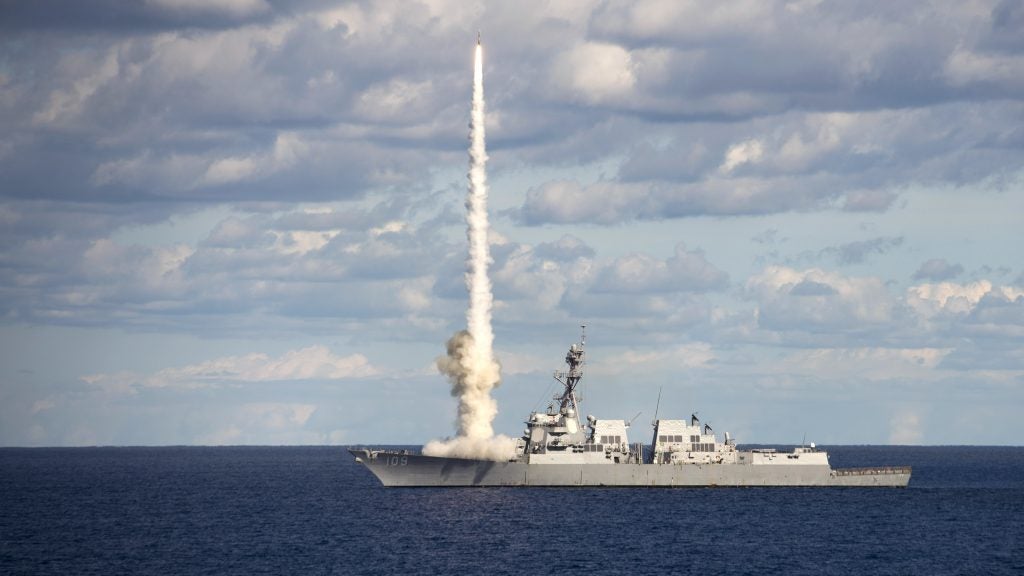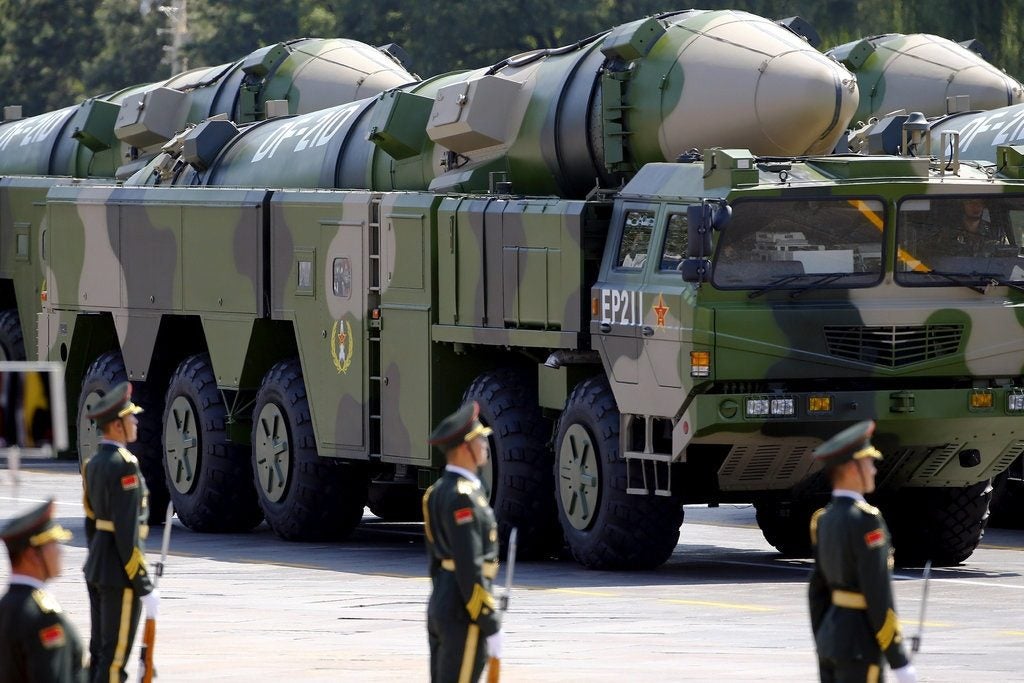Chinese Anti-Ship Ballistic Missiles: Over Hyped or a True Carrier Killer?
China has developed anti-ship ballistic missiles, and wants the world to know it. From parades to propaganda, the PLA has touted their DF-21 and DF-26 missiles as a Sword of Damocles hanging over the Pacific Ocean, waiting to chop off an invading force at the neck. However, despite the brash talk, serious questions remain about the validity of this technological revolution and the true threat it poses to US Navy forces.
The US Navy spent four decades during the Cold War theorizing on how to fight and survive in the face of overwhelming swarms of Russian anti-ship missiles. This culminated with the SPY-1 radar tied to the AEGIS combat system which has never failed to protect a ship it was mounted on in actual combat, and has been proven thousands of times over in exercises and drills. While AEGIS played a very small part in the Persian Gulf conflicts of the mid-80s through Desert Storm, the American military showed the world rather comprehensively what would happen to those playing by the Soviet book.

China paid attention to this, scrapping a significant portion of its existing doctrine, and returning to the theoretical drawing board when it realized that if it went to war with the United States circa 1992, it would lose in dramatic fashion. The problems facing the PLA were many-fold, but one of the primary ones was the relative inability to neutralize the USN’s ability to sail aircraft carriers with impunity wherever they chose to. The rapid power projection offered by carriers meant that the USN could offer a credible response to any Chinese action days if not weeks before the USAF and other armed services could mobilize to the region.
At some point, the decision was made that in addition to a comprehensive and growing suite of anti-ship missiles, that something else would be needed. While an official history is not available, it is likely that this was the genesis of the PLA’s anti-ship ballistic missile force. The DF-21 MRBM, with a nominal range of 1,100nm, was an ideal choice to develop this new weapon on. It boasted both useful range and payload, having been designed to carry nuclear payloads if need be.
The history of the PLA’s AShBM program is unclear. Sometime between Desert Storm and the official announcement in 2010, the Chinese developed the baseline DF-21 into the DF-21D, and claimed its ability to hit enemy warships at sea. This initial claim, and the many more made after it, have spurred the western defense establishments into a furor of speculation. While there are certainly valid concerns over the claimed capability, the aspects of the DF-21 and its successors need to be examined in detail to properly analyze the threat they pose to western naval forces.
As a Standalone System
AShBMs face a great number of challenges in actually hitting and sinking their targets. The largest of these issues can be summarized by the term “kill chain”, or the sequence of targeting events needed to get the missile into the right place in order for it to find, and lock onto, a targeted ship. China has launched at least two standalone, and two constellations of satellites to enable this capability. However, locating a ship, or more likely a Surface Action Group or Carrier Strike Group from space, as the satellites enable, is not the same as getting a targeting-worthy track.
In this, the Chinese run into the same problems the Soviets did with their Naval Aviation regiments. The ocean is very large, and comparatively, ships are very small. Finding ships that do not want to be found is easier than it used to be, but still phenomenally difficult. The first challenge is even knowing where to look. There are thousands of ships at sea at any given time, and discerning the wheat from the chaff, so to speak, is remarkably difficult. Hiding at sea, while ever more difficult, is still a viable tactic, even in the era of digital satellites and a mobile phone in every pocket.
Simply finding an American or allied task force in the middle of the ocean, however, is not enough to sink it. The PLA will then have to do two things: retain contact with the force, and refine that contact into a targeting-quality solution. These provide their own significant challenges, especially when one takes the AShBM by themselves. By nature of their long range, the DF-21 and DF-26 have relatively long flight times, so a task force must be ‘led’, like a tank shooting at a moving target. During the mid-point of that flight, the targeting systems must communicate with the final stage of the missile to correct its course in order for it to come down in the right geographic area so its comparatively limited onboard sensors can acquire and fix the ships it is there to kill.
As Part of an A2/AD ‘Bubble’
This kill chain has serious weaknesses. Satellites, while fantastic for surveying large quantities of ocean at any given time, cannot keep contact on a surface force by virtue of being in orbit. While constellations of reconnaissance satellites may keep PLA commanders updated on a regular basis with the position of a task force, these satellites have inherent limitations in sensor resolution, time on station, and maneuverability. They can also be shot down. In order to be low enough to use active and passive sensors to detect surface forces, all ocean reconnaissance satellites are in Low Earth Orbit (LEO). This puts them in range of the SM-3, carried in varying numbers by most Aegis-equipped destroyers and cruisers.

None of this is to say that AShBMs do not pose a valid threat to US Navy surface forces. They do. While well funded, the PLA, and China at large, does not have infinite funds and cannot invest as heavily as it has into systems that it does not believe are worth the cost. However, the true utility of AShBMs is not as a “silver bullet” carrier killer as many in the media like to think. The value of these systems lies within their interoperability with China’s other means of maritime strike.
China has one of the largest arsenals of anti-ship cruise missiles in the world. These vary from antiquated evolved copies of the venerable SS-N-2 Styx, to highly modern and dangerous missiles like the YJ-12. Intelligently employed mass salvos of these weapons from tactical aircraft, surface forces, and submarines would be a serious challenge to any Western surface force in the world. Such salvos would empty missile magazines, use up chaff, flares, and decoys, and cause damage to ships and casualties among crews.

Chinese naval warships fire missiles during a live-fire military drill in the waters of Bohai Sea and Yellow Sea, off China’s east coast, August 7, 2017. Photo courtesy Reuters.
The real threat of AShBMs then, is the additional pressure they add to a surface group’s defenses. If a force has to defend against both ballistic and cruise threats, it will have to parcel out some of its precious magazine space for dedicated anti-ballistic missile interceptors. This, in turn, will reduce its survivability when under attack by cruise missiles. If the force is in the highly unfortunate position to be under attack by both cruise and ballistic missiles at the same time, it will have to figure out which radars to point skyward and which to leave in their normal elevation. In the case of a combined attack, even if the ballistic missiles get no kills themselves, they will likely enable kills by the cruise missiles by splitting the resources of the force under attack.
The Future?
What is more likely, is that salvos of ballistic missiles will begin at ranges far in excess of those of the PLA’s cruise missiles. These initial salvos will eat up missiles and decoys, not to mention any damage or casualties they cause. Moreover, they will force sailors to battle stations and into high stress environments, meaning they will most likely not be at 100% readiness when the cruise missiles find this notional surface force. The lethality and capabilities of anti-ship cruise missiles is well known, and high end options will require the defender to be absolutely perfect to avoid serious losses.
As a concept, and now seemingly as a reality, Anti-ship ballistic missiles are here to stay. Whether or not the systems the PLA currently has in service live up to their advertising, Chinese officials obviously believe they are worth the investment. It is in fact, even likely that the DF-21D will have serious problems engaging US Navy surface forces doing their level best not to be hit. However, the DF-26 and its successors will likely be more capable, posing serious threats to the free movement of US and allied naval forces within the ballistic missile umbrella these systems provide to the PLA.

And its not just China getting on the AShBM train. The US Army’s future precision strike missile, the in-development ATACMS replacement, will include some anti-ship capability. While that weapon is likely to be more of a Short or Medium Range Ballistic Missile than the IRBM class DF-26, the concept is evidently attractive to the US Army.
AShBMs will proliferate beyond China’s borders, until such time as the defensive countermeasures against them render them useless or requiring excessive numbers to be worthwhile. Even then, one could say such a thing has happened to the anti-ship cruise missile, and they are evolving by the decade.

